Healthcare is moving increasingly toward personalized approaches — tailoring treatment based on each patient’s unique disease. Precision medicine is well-established in oncology, with many cancers now characterized by their unique genomic alterations. In the past few years, the Food and Drug Administration has approved several treatments based on an individual’s genetic makeup or genetic variants of his or her disease.
Since the first personalized medicine approval for HER2 positive breast cancer in 1998 — Genentech’s Herceptin — there have been major breakthroughs happening every year across multiple disease indications, from autoimmune disorders to genetic conditions to cancer. Advances in precision medicine, with new diagnostics and new therapies that allow for even greater precision are expected to continue.
An example of the advancements taking place is the 2017 FDA approval of Merck’s Keytruda, which was based on the genetic profile of a tumor, rather than the tissue or tumor type.
Industry leaders say the FDA’s approval for Keytruda for all solid tumors with microsatellite instability (MSI) high status, regardless of location within their body, underscores the need to identify the molecular changes that drive a patient’s cancer to identify a potential benefit from immunotherapy, and highlights why the industry needs to move toward comprehensive genomic profiling.
This research was done in collaboration with researchers at Johns Hopkins, which had been working on cancers that have gene mutations that regulate DNA.
“In collaboration, we performed a study involving patients with different types of cancer who all carried the unique mutation in DNA repair gene, which can be detected by a commonly available mismatch repair test," says Eric Rubin, M.D., head of early oncology 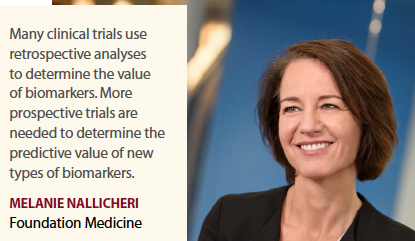 development, Merck Research Laboratories. “It turned out these identified patients responded quite well to Keytruda, which ultimately led to receiving breakthrough designation from the FDA, and ultimately approval from the FDA. Keytruda is the first example of a drug that was approved on the basis of a genetic alteration in the cancer rather than a particular cancer type."
development, Merck Research Laboratories. “It turned out these identified patients responded quite well to Keytruda, which ultimately led to receiving breakthrough designation from the FDA, and ultimately approval from the FDA. Keytruda is the first example of a drug that was approved on the basis of a genetic alteration in the cancer rather than a particular cancer type."
Precision medicine is an integral part of Merck’s development strategy, Dr. Rubin says.
“Before a molecule ever enters the clinic, we strive to understand the appropriate tests to identify patients who are likely to respond," he says. “This is no doubt true for many companies, as we now recognize the importance of tests to identify patient need. This step happens very early in the development process."
On the day PharmaVOICE spoke with Dr. Rubin, two researchers were awarded the Nobel Prize in Physiology or Medicine for their basic research that identified immune-based targets. Working separately, James P. Allison and Tasuku Honjo demonstrated how different strategies for inhibiting the brakes on the immune system could be used to 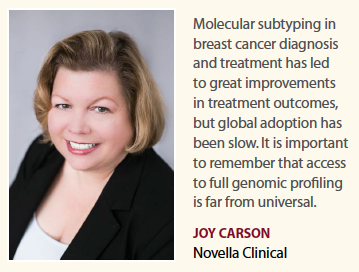 treat cancer. It was Dr. Honjo’s research of PD-1, a protein on T cells that stops the immune system from attacking cancer, which informed the development of Keytruda.
treat cancer. It was Dr. Honjo’s research of PD-1, a protein on T cells that stops the immune system from attacking cancer, which informed the development of Keytruda.
Keytruda and other PD-1 inhibitors work to block the PD-1/PD-L1 pathway and prevent cancer from hiding from the immune system.
Taking the Measure of Precision Medicine
Precision medicine is the idea of applying the right treatment to the patient’s situation, says Ilan Danieli, CEO of Precipio. “If we don’t have a picture of the patient’s clinical situation, precision medicine falls apart. The starting point is understanding the genetic footprint of the patient — understanding what the biology of the tumor is — in order to apply the proper treatment."
He says diagnostics will play an even greater role in the future because it won’t be used just as an up-front, one-time tool, but rather as an ongoing tool to assess the biology of the tumor as it changes and evolves.
The promise of real-time oncology treatment would be to monitor a patient daily or weekly, to detect the recurrence of the cancer at a very early stage, and be able to tailor or change treatment to prevent a full-blown recurrence, says Rachel Laing, managing partner, Bionest Partners. “The tools to enable this therapeutic approach are being developed and improved as we speak — liquid biopsy, next-generation sequencing, digital tools to track a patient’s response and symptoms — and will be critical to fully achieve the promise of precision medicine."
Ms. Laing says finding ways to manage the data generated from these measurements will be just as critical: technologies to amass, analyze, and execute meaningfully large amounts of data are needed.
“We have already moved, in many instances, from measuring one gene via PCR to measuring a panel of genes by next-generation sequencing," she says. “Lastly, we are likely to see an integration of digital technologies, be it to improve R&D efficiency, help with clinical trial management and recruitment, or improve patient management and treatment tailoring."
Big data is poised to accelerate development and innovation in precision medicine, says Jackie Kent, senior VP, global head of product, Medidata Solutions.
“The velocity and variety of data are accelerating in clinical trials, making integration and standardization more complex," she says. “In addition, precision medicine takes into 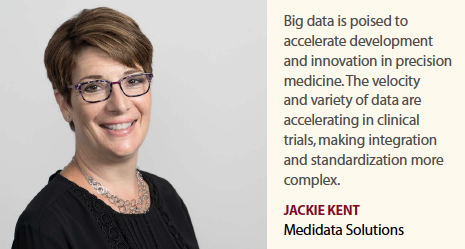 account individual variability in genes, environment, and lifestyle, greatly increasing the complexity of the clinical trial design as compared with the one-size-fits-all approach taken in traditional drug development. Relevant clinical trial data solutions are needed to ensure advancements in precision medicine are efficient and cost-effective."
account individual variability in genes, environment, and lifestyle, greatly increasing the complexity of the clinical trial design as compared with the one-size-fits-all approach taken in traditional drug development. Relevant clinical trial data solutions are needed to ensure advancements in precision medicine are efficient and cost-effective."
But few companies have been able to capitalize on the promise of precision medicine. Doing so requires a dramatically new set of capabilities.
We have come a long way, but we’re not quite there yet, says Melanie Nallicheri, chief business officer and head, biopharma, Foundation Medicine. “Many clinical trials use retrospective analyses to determine the value of biomarkers, and it will be important to conduct more prospective trials to determine predictive value of new types of biomarkers. I expect that the complexity of the underlying biomarkers will change over time and the technologies we will be using will evolve as well."
She says Foundation Medicine will add gene expression profiling to its understanding of the underlying biology and leverage these insights to develop new biomarkers.
Comprehensive genomic profiling, Ms. Nallicheri says, can save time and precious tissue 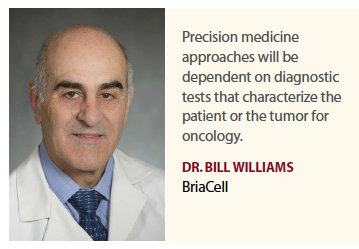 for advanced cancer patients. “Single biomarker tests using common diagnostic techniques such as PCR, IHC, and FISH, and multigene hotspot NGS tests, don’t always identify genomic alterations, which could be critical to a patient’s treatment plan. In addition, sequential single biomarker testing may result in tissue exhaustion before all disease-relevant genes have been tested."
for advanced cancer patients. “Single biomarker tests using common diagnostic techniques such as PCR, IHC, and FISH, and multigene hotspot NGS tests, don’t always identify genomic alterations, which could be critical to a patient’s treatment plan. In addition, sequential single biomarker testing may result in tissue exhaustion before all disease-relevant genes have been tested."
Dr. Rubin points out that for Keytruda’s tissue-agnostic approval, the tests used during the trials — one involved detection of proteins, a common method known as immunohistochemistry, and another is a DNA-based test that involved the polymerase chain reaction — were not FDA approved at the time for the purposes that Merck wanted to use them.
“They were commonly used to detect alterations that can be inherited, particularly in colon cancer," he says. “The FDA has required a postmarketing commitment to pursue these approved tests, and one of our diagnostic partners in the space is Foundation Medicine."
With the growing number of diagnostic tests available on the market, it’s becoming increasingly more complex for researchers and physicians to identify patient treatment options, says Elizabeth Hans, business strategy manager, Accenture Life Sciences.
“Physicians not only need to understand the number of tests available to them, but also how the tests work, what they identify, and how to read the results in order to make critical decisions for their patients’ treatment options," she says. “A recent study in the Washington Post reported that out of 100 physicians surveyed to gauge their understanding of the risks and benefits of 10 common tests, 80% of the physicians overestimated the benefits. This complex space requires more involvement from patients, researchers, and companies to ensure the right treatment decisions are being made for patients."
The Future Promise of Precision Medicine
The global precision medicine market was valued at about $43.59 billion in 2016 and is estimated to reach $141.7 billion by 2026, according to BIS Research. The market is expected to grow at a compound annual growth rate (CAGR) of 11.23% between the years 2017 and 2026, aided by the adoption of early diagnosis, increased number of adverse drug reactions cases, high prevalence of chronic diseases, and advancements in genetic science, among other market drivers.
Precision medicine involves a detailed study on patient-specific information to diagnose and characterize disease. The concept of precision medicine is rapidly growing in the medical community through the tremendous expansion of various advanced technologies, such as next-generation sequencing, molecular biomarker analysis, bioinformatics, and big data analytics, among others.
By applying a deeper understanding of diseases with richer patient data and advanced analytics, precision medicine can help physicians tailor treatments to the needs of individual patients once they get sick, rather than applying standard treatments determined by broader populations.
Industry leaders say with the entrance of big tech companies into the health space, such as Apple and others, we are now closer than ever to collecting personalized information and biometric data in real time. This nudges us closer to the vision of precision and personalized medicine, but at the same time, they say we are just scratching the surface of what might be possible.
The industry is clearly at a critical inflection point, says Kevin Hrusovsky, chairman and CEO, Quanterix.
“While we’ve recognized the potential of precision medicine to disrupt healthcare, we’ve yet to fully see the transformation take place," he says. “With valuation of the precision medicine market estimated to be more than a $141 billion by 2026, there is clearly a strong appetite and while we are indeed close, there is still a lot more we can do. The innovation curve intrinsically depends on our ability to advance technologies that are helping to fuel breakthroughs in this area, from optimizing and accelerating the drug development process to monitoring disease cascades for individual patients to reducing drug toxicity and side effects. Closing the gap between promise and reality will require collective will, but also increased funding, regulatory changes, and a commitment from the scientific and medical community."
In theory, we are making great progress, agrees Joy Carson, senior director, oncology strategy, Novella Clinical.
“In practice, we are just beginning to build a meta-database of cancer targets — many of which do not yet have approved treatments," she says. “It is a data engine that will drive 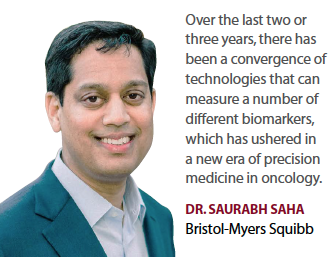 drug development, but it will take many years to reap the benefits of this knowledge with effective targeted therapies. For example, molecular subtyping for breast cancer diagnosis has led to great improvements in treatment outcomes, but global adoption has been slow."
drug development, but it will take many years to reap the benefits of this knowledge with effective targeted therapies. For example, molecular subtyping for breast cancer diagnosis has led to great improvements in treatment outcomes, but global adoption has been slow."
Fewer than one in five patients who had their tumor biopsies tested using next generation sequencing could be matched to one of 30 targeted therapy drugs, according to the National Cancer Institute’s precision medicine treatment clinical trial (MATCH) interim analysis.
In another paper published in JAMA Oncology, it was reported that fewer than 5% of patients benefited from genome-driven targeted therapy in 2018.
“Clearly, some patients benefit from genome-driven precision medicine, but we have a long way to go to deliver the promise of precision medicine to everyone," says Christian Apfel, M.D., Ph.D., founder and CEO, SageMedic.
He says the future lies in functional profiling, i.e. technologies where the tissue of a patient’s live cancer biopsy is exposed to various treatment options in the laboratory or ex-vivo in order to identify the most effective treatment. Once genome-free, live-cell, functional profiling assays become more established, researchers and pharmaceutical companies will be able to develop targeted therapies more quickly and with higher success rates.
“Likewise, once clinical trials have demonstrated improved patient outcomes and reduced costs using live cell assays, oncologists and insurance companies will adopt these models; patients will then have much better outcomes, lowering healthcare costs for society," he says.
For pharmaceutical companies, the next five years will be key. Precision medicine is expected to shake up the value chain. And industry leaders say companies can either work to transform their businesses or be left behind as peers and new disruptive entrants move forward. (For additional coverage, see the PharmaVOICE digital edition.)
Although companies in the pharmaceutical and healthcare industries know this is the way forward, they face some significant hurdles. PwC’s survey of global leaders in the pharmaceutical industry show that 92% have identified precision medicine as an opportunity and 84% have it on their corporate agenda. But most companies have yet to harness the full potential of precision medicine.
PwC says external barriers include insufficient access to high-quality data, an unclear regulatory framework, a lack of standards, and data privacy issues. Internally, many companies lack the capabilities — particularly regarding the generation, integration, analysis of non-trial related patient data — that precision medicine requires.
Rather than waiting for regulators and data standards to emerge, companies need to actively work with regulators, policymakers, and other stakeholders to develop standards. And they will likely need to consider a new operating model that is more agile and responsive to changes. Companies need to take risks and more actively engage with stakeholders throughout the healthcare ecosystem.
The future of precision medicine, experts say, will be the ability to be more precise in the measurement, testing, and treatment of diseases.
Over the last two or three years, there has been a convergence of technologies that can 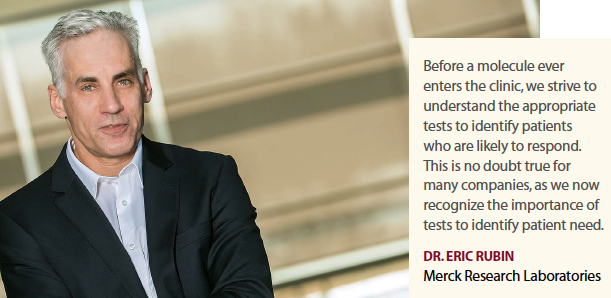 measure a number of different biomarkers, which has ushered in a new era of precision medicine in oncology, says Saurabh Saha, M.D., Ph.D., senior VP and global head of translational medicine, Bristol-Myers Squibb.
measure a number of different biomarkers, which has ushered in a new era of precision medicine in oncology, says Saurabh Saha, M.D., Ph.D., senior VP and global head of translational medicine, Bristol-Myers Squibb.
“This convergence allows us to answer a multitude of questions, such as: who are the right patients who would best respond to a therapeutic so they can be selected ahead of time, and what are the indications that may be most responsive to the immunotherapies we have in the pipeline," he says.
For Bristol-Myers Squibb, addressing these questions and having the technology in place involved creating a new translational medicine division, which sits between discovery and development to inform decision-making. Established last year, the team aims to bring together the right talent and expertise to answer fundamental questions about a new therapeutic discovery, evaluate whether the new therapy is having a disease modifying activity, and ultimately determine if the agent can be translated into a viable therapy someday.
“We have built an organization that encompasses an incredible breadth of scientific expertise matched with enabling technologies that we can deploy to analyze patient samples," Dr. Saha says. “As examples, we’re now able to visualize the pathology of tumors using artificial intelligence, to look at the histology of a tumor with much more specificity, identify the cell types present in the tumor, their spatial locations relative to each other, and so on. We can now conduct whole-body imaging with tumor specific PET tracers targeting ligands such as PD-L1, which can tell us which tumors are lighting up PD-L1 positive versus negative to inform appropriate selection of therapies as well as determine the biological activity of novel experimental cancer medicines. We no longer have to rely solely on a biopsy."
Advanced Diagnostics for Precision Medicine
In the past decade, “omics" technologies have progressed quickly, from tools that look at single molecules to testing multiple biomarkers. These advancements, combined with artificial intelligence, are ushering in a new era of advanced diagnostics that will transform the understanding and treatment of many diseases.
According to the Personalized Medicine Coalition, the market value of the targeted therapeutic drugs dependent on companion diagnostics was valued to be $25 billion in 2015. Also, the number of precision medicine or personalized medicine drugs that point to specific biomarker has steadily increased from five in 2008 to 132 in 2016.
A recent survey conducted by the Tufts Center for Drug Development reported that 42% of the drugs in the development pipeline include biomarkers in their design. The survey also suggests that several biopharmaceutical companies have doubled their investments over the last five years in precision medicine, and are expected to increase their investments by an additional 33% over the next five years.
According to Global Market Insights, the companion diagnostics market is poised to be one of the fastest-growing segments at a CAGR of more than 11.5% because of the ability to provide essential information for the safety and effectiveness of a specific drug or therapeutic product for targeted patient groups.
Clinical-grade tumor test results with actionable information have had an impact on care that is important to patients and their outcomes as well as on healthcare economics and on societal costs, says Steven Shak, M.D., co-founder, chief scientific officer and chief medical officer, Genomic Health.
“For example, our breast cancer assay has saved the healthcare system more than $5 billion," he says. “It’s clear now that cancer is very complicated, and treatment is going to require more sophisticated diagnostics and new therapies."
Genomic Health’s Oncotype DX was one of the earliest genomic-based diagnostics. It applies advanced genomic science to reveal the unique biology of a patient’s tumor in order to optimize cancer treatment decisions. The company’s best-known and most impactful test is Oncotype DX Breast Cancer Recurrence Score, which examines the activity of 21 genes in a patient’s breast tumor to provide personalized information for tailoring treatment.
“We now know that the Recurrence Score not only tells a newly diagnosed breast cancer patient the likelihood of her cancer recurring, but most importantly whether chemotherapy would be beneficial or not," Dr. Shak says. “The test has completely 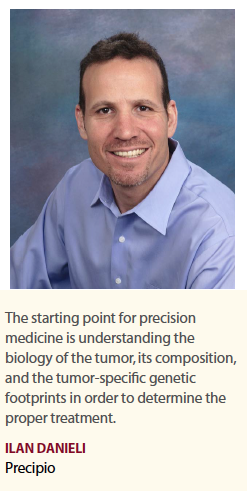 transformed the treatment of breast cancer. In 2000, standard treatment to the vast majority of newly diagnosed breast cancer patients was chemotherapy. Through the work we’ve done, we’ve found that the vast majority of patients can be treated with hormonal therapy alone and be spared the cost and toxicity of chemotherapy."
transformed the treatment of breast cancer. In 2000, standard treatment to the vast majority of newly diagnosed breast cancer patients was chemotherapy. Through the work we’ve done, we’ve found that the vast majority of patients can be treated with hormonal therapy alone and be spared the cost and toxicity of chemotherapy."
He and others in the advanced diagnostics space are excited about the new field of “liquid biopsies," which use blood samples to assess tumors. Based on its partnership with Epic Sciences, Genomic Health has launched the Oncotype DX AR-V7 Nucleus Detect test, which detects AR-V7 proteins in the nucleus of the circulating tumor cells through a blood test to help guide treatment decisions for men with metastatic castration-resistant prostate cancer (mCRPC).
“This is another step forward in the way in which we can extend the lives of men with prostate cancer," he says.
Foundation Medicine is another company with a test that detects genetic mutations. The company offers a full suite of comprehensive genomic profiling tests to identify the molecular alterations in a patient’s cancer and match them with relevant targeted therapies, immunotherapies, and clinical trials. This includes FoundationOne CDx, the first FDA-approved comprehensive genomic profiling assay for all solid tumors incorporating multiple companion diagnostics.
CDx also reports microsatellite instability (MSI) status as well as tumor mutational burden, which can help inform immunotherapy decisions.
Foundation Medicine also offers FoundationOne Liquid, the company’s most recent advance in liquid biopsy testing. Using a blood sample, FoundationOne Liquid analyzes 70 genes known to drive cancer growth, including homologous recombination deficiency genes, and reports microsatellite instability high status, that may help inform the use of checkpoint inhibitor immunotherapies and multiple targeted therapies, including poly polymerase inhibitors. Because many advanced cancer patients cannot undergo a traditional tissue biopsy, there is a significant need for minimally invasive solutions to help inform personalized medicine decisions.
Another company working in the liquid biopsy space is Precipio. Mr. Danieli says the company’s focus is on addressing the problem of misdiagnosis by improving diagnostic accuracy.
The company licenses a technology from Harvard, called ICE COLD PCR, which enables laboratories to evaluate — in a very efficient, quick, and cost-effective way — a blood sample to identify tumor DNA, separate it from the regular DNA, and then enrich it to the point where the laboratory can generate meaningful genetic information of the patient’s tumor and the biology of the patient’s cancer.
Mr. Danieli says tests such as these are needed for several reasons: the current ways cancer patients are grouped is not specific to the individual patient, and the biology of the cancer can change over time.
“At any point in a cancer patient’s journey he or she may be given a treatment that, after a while, no longer works because the care team is relying on genetic information that was identified at disease onset when the first biopsy was done, whereas that genetic information can change over time," he says. “Liquid biopsy is going to be a game changer in this field. A biopsy is an invasive process, and is not easily repeated, especially as cancer patients become very frail."
Moving to less invasive techniques for biomarker detection through either liquid biopsy or other matched samples is a significant area of research.
“This of course means using matched samples to validate new diagnostics," says Cliff Raynor, senior VP of clinical operations, BioIVT. “In addition, developers of diagnostic assays face other challenges ranging from achieving regulatory approval to securing intellectual property protection."
Bill Williams, M.D., president and CEO of BriaCell, says diagnostic tests that can characterize the patient or the tumor are the key to precision medicine.
BriaCell’s research is aimed toward combining the effectiveness and safety of personalized medicine with off-the-shelf options such as targeted cancer immunotherapies tailored to provide advanced breast cancer patients with safe and effective treatment options.
The company’s most advanced product, Bria-IMT, is a genetically engineered human breast cancer cell line with features of immune cells. It is clinically applied as a targeted immunotherapy. The mechanism of action of Bria-IMT is currently under investigation, although the company has shown that Bria-IMT simulates T cells, a key component of the immune system and antibody responses against tumor cells.
“We suspect that the expression of certain immunogenic peptides in Bria-IMT generates strong antibody and T-cell responses, which results in recognition and destruction of cancerous cells," Dr. Williams says. “We take a breast cancer cell line, and then we use it to immunize patients who have the same type of cancer. This approach has the same features of an immune cell, or a so-called antigen presenting cell."
The company is developing a corresponding diagnostic test, BriaDX, to select the right off-the-shelf alleles for each specific patient prior to treatment, creating a personalized therapy without the need for personalized manufacturing.
“We are developing a number of cell lines that can express different HLA types using molecular biology and genetic engineering to enable us to cover about 90% of the patient population," Dr. Williams says.
Mr. Raynor says co-development of therapies and diagnostics can improve the success rate and address some of these challenges, but regulators and insurers need to keep up with the science and new approaches to medicine to ensure continued momentum.
“In addition, precision medicine needs faster growth and application in non-oncology areas," he says. “The field holds great potential in cardiovascular, neurological, and immune-related areas. Expanding the use of precision medicine to include risk assessment, prevention, and detection for a multitude of diseases and disorders allows a multi-faceted approach to patient care." (PV)
~~~~~~~~~~~~~~~~~~~~~~~~~
Precision Medicine: Potential and Reality
 The NIH Precision Medicine Initiative says precision medicine is “an emerging approach for disease treatment and prevention that takes into account individual variability in genes, environment, and lifestyle for each person." Precision medicine has been fundamental to the biopharmaceutical and medical diagnostics communities for 20 plus years. By 2019, as many as half of the novel agents approved by the FDA could be precision therapeutics linked to precision molecular diagnostic tests — complementary or companion — of some type.
The NIH Precision Medicine Initiative says precision medicine is “an emerging approach for disease treatment and prevention that takes into account individual variability in genes, environment, and lifestyle for each person." Precision medicine has been fundamental to the biopharmaceutical and medical diagnostics communities for 20 plus years. By 2019, as many as half of the novel agents approved by the FDA could be precision therapeutics linked to precision molecular diagnostic tests — complementary or companion — of some type.
Currently, about 25% of patients being treated at a National Comprehensive Cancer Network center with advanced cancer in the United States are receiving innovative drugs matched to DNA mutations in their tumors. Importantly, this type of therapy has started to penetrate the community oncology space.
Gene therapy has already been shown to work — up to a point — for patients with hemophilia A and B. Imagine a child at risk for hemophilia A because of a defective gene. We can already identify the defective gene while the fetus is in utero. Hypothetically, we could implant the correct gene into fetal DNA, and the child could be born without genetic defect. Might we see the first such case in 2019? The FDA and NIH have just reassessed their perspectives on gene therapy trials to speed time to market.
Anticipating and monitoring the impact in this space is the Precision Medicine Initiative called “All of Us," which is scheduled to enroll 1 million or more participants and track their health data for years with precision. As of September 2018, 100,000 individuals were enrolled or were in the process of enrolling.
Source: Mike Scott, Medical Researcher, Calcium
~~~~~~~~~~~~~~~~~~~~~~~~~
Precision Medicine In Neurological Disorders
A Diagnostic Test for Autism
 Elizabeth Donley,
Elizabeth Donley,
CEO, Stemina Biomarker Discovery and NeuroPointDX,
@NeuroPointDX
Our goal at NeuroPointDX is to bring the promise of precision medicine to diagnosing and treating neurological disorders more precisely. Our first diagnostic test is for autism spectrum disorders (ASD).
Using our metabolomics platform technology, we were able to identify the first set of biomarkers to diagnose and give insight in the underlying metabolism of a subset of children with ASD. These biomarkers were validated through our clinical study, the Children’s Autism Metabolome Project (CAMP) and published in Biological Psychiatry in September 2018.
CAMP is the largest study of the metabolism of children with ASD ever conducted. This test will assist in earlier diagnosis and more precise treatment of children with ASD based on differences in metabolism.
Precision Medicine in Mental Health
 Dr. Kenneth Koblan
Dr. Kenneth Koblan
Head of Global Translational Medicine and Early Development and Head of Discovery Sciences, Sunovion Pharmaceuticals
Unlocking the full potential of precision medicine in mental illness will require not only refining our psychiatric assessment tools, but a better understanding of the myriad of factors that influence how these disorders emerge and develop.
It is important to understand that mental illnesses are qualitatively different from other diseases. Most of the time, psychiatrists can’t use biochemical tests or MRIs to diagnosis mental illnesses; instead, they observe how patients behave and ask questions about thoughts and feelings. We simply don’t understand the underlying genetics and biology of mental illness in the same way as other medical conditions or even other brain disorders, such as multiple sclerosis or Parkinson’s disease, for example. However, we can use what we do know about genetics, neurobiology, and behavioral science of mental illness to improve diagnosis and treatment.
The idea is to move away from using the lists of symptoms describing specific mental disorders, as noted in the Diagnostic and Statistical Manual of Mental Disorders (DSM), and toward an approach that emphasizes what is known about the biological roots of mental illness.
This transition is essential if we are ever to bring mental illness into the precision medicine era. In the case of schizophrenia, an analysis we recently performed lays the groundwork for further steps in that direction. Using this new statistical analysis, we were able to build and improve upon the PANSS (Positive and Negative Syndrome Scale), used in most schizophrenia clinical trials, to isolate different clusters of schizophrenia symptoms.


















